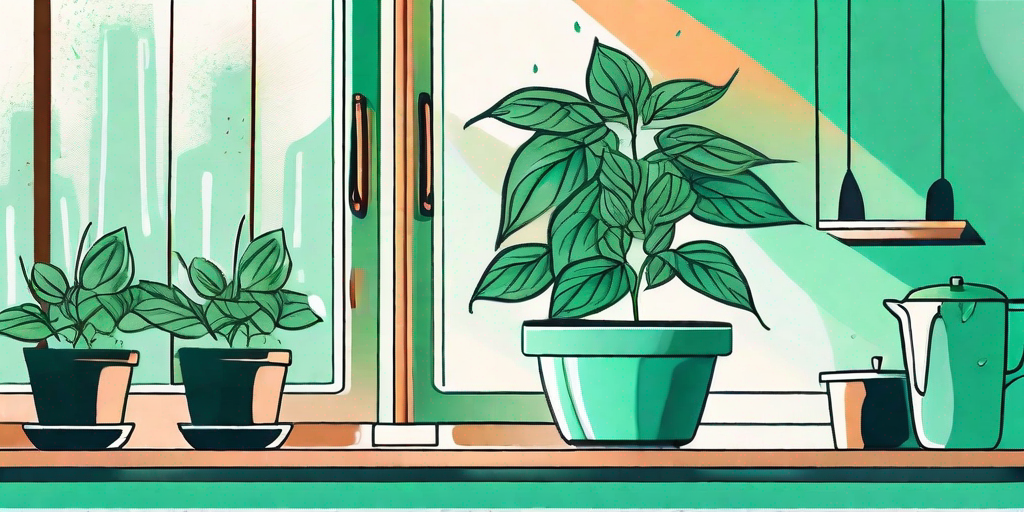
If you've ever wanted to add a little zest to your life, why not consider growing your own Thai basil plant? This aromatic herb is not only a staple in many Thai dishes, but it's also a delightful addition to your home garden. No need to worry if you don't have a green thumb. This guide will walk you through every step of the process, from planting the seeds to harvesting the leaves. So, let's get started and spice up your life!
Understanding Thai Basil
Before we dive into the nitty-gritty of growing Thai basil, let's take a moment to appreciate this magnificent plant. Thai basil, or Ocimum basilicum if you want to get scientific, is a member of the mint family. It's native to Southeast Asia, but has made its way into kitchens around the world.
Thai basil is known for its unique flavor profile. It has a sweet, anise-like flavor with a hint of spiciness. It's this distinct taste that makes it a star in many Thai dishes, from green curry to pad Thai. But don't limit yourself to just Thai cuisine. This versatile herb can jazz up your salads, soups, and even cocktails!
Getting Started with Your Thai Basil Plant
Choosing the Right Seeds
Like any great endeavor, growing Thai basil starts with choosing the right seeds. You can easily find Thai basil seeds online or at your local garden center. Look for seeds that are organic and non-GMO to ensure you're getting the best quality.
Remember, not all basil seeds are created equal. There are many varieties of basil, and each has its own flavor profile. Make sure you're getting Thai basil seeds, not sweet basil or holy basil. The packaging should clearly state "Thai basil".
Preparing the Soil
Thai basil isn't too picky about soil, but it does prefer well-draining soil. You can use a standard potting mix, or make your own by combining equal parts garden soil, compost, and perlite or sand. This will ensure the soil drains well and provides the nutrients your Thai basil needs to thrive.
Before planting your seeds, moisten the soil with water. It should be damp, but not waterlogged. This will create the perfect environment for your seeds to germinate.
Planting and Caring for Your Thai Basil
Planting the Seeds
Now that your soil is ready, it's time to plant your seeds. Sprinkle the seeds on top of the soil, then lightly cover them with more soil. They should be about 1/4 inch deep. If you're planting multiple seeds, space them about 10 to 12 inches apart to give them room to grow.
Place your pot in a sunny spot. Thai basil loves the sun and needs at least six hours of sunlight each day. If you're growing your Thai basil indoors, place it near a south-facing window or under a grow light.
Watering and Fertilizing
Water your Thai basil regularly, but be careful not to overwater. The soil should be kept moist, not soggy. Overwatering can lead to root rot, which is a death sentence for your plant. A good rule of thumb is to water when the top inch of soil feels dry to the touch.
As for fertilizing, Thai basil isn't too demanding. A balanced, slow-release fertilizer applied every few weeks should do the trick. You can also add compost to the soil to provide extra nutrients.
Harvesting and Using Your Thai Basil
After all your hard work, it's finally time to reap the rewards. You can start harvesting your Thai basil once it has at least six pairs of leaves. Simply snip off the top pair of leaves, and new ones will grow in their place. This will also encourage the plant to become bushier.
Now, what to do with your bounty of Thai basil? The possibilities are endless! Use it fresh in salads, stir-fries, and soups. Or dry it to use in teas and spice blends. You can even make Thai basil pesto or infused oils. The world is your oyster, or in this case, your Thai basil plant!
Frequently Asked Questions
- Can I grow Thai basil indoors?
Yes, Thai basil can be grown indoors as long as it gets enough sunlight. Place it near a south-facing window or under a grow light. - How often should I water my Thai basil?
Water your Thai basil when the top inch of soil feels dry to the touch. Be careful not to overwater, as this can lead to root rot. - Can I use Thai basil in place of sweet basil?
While they have different flavor profiles, Thai basil can be used in place of sweet basil in most recipes. Just keep in mind that Thai basil has a stronger, spicier flavor.
So there you have it, folks. Growing your own Thai basil is as easy as pie, or should we say, as easy as green curry? With a little love and care, you'll be enjoying your homegrown Thai basil in no time. So go on, spice up your life!











